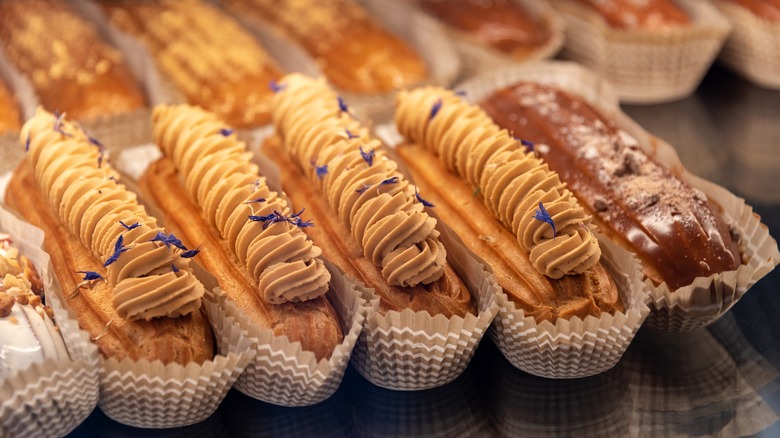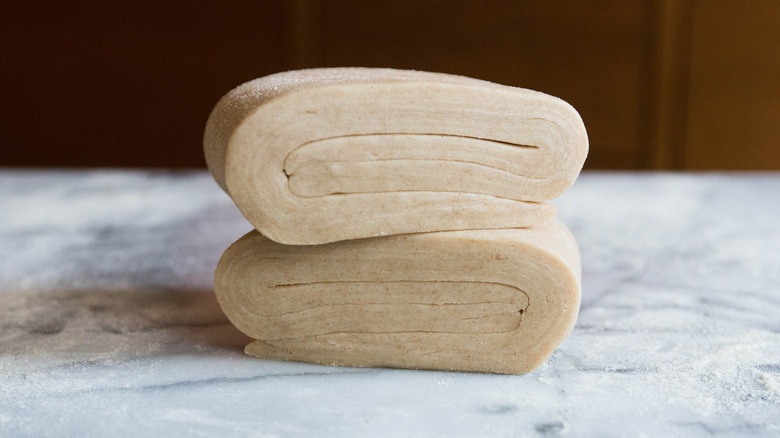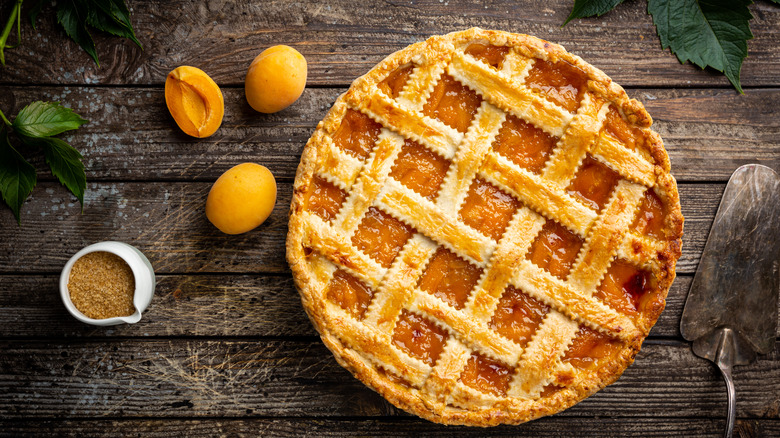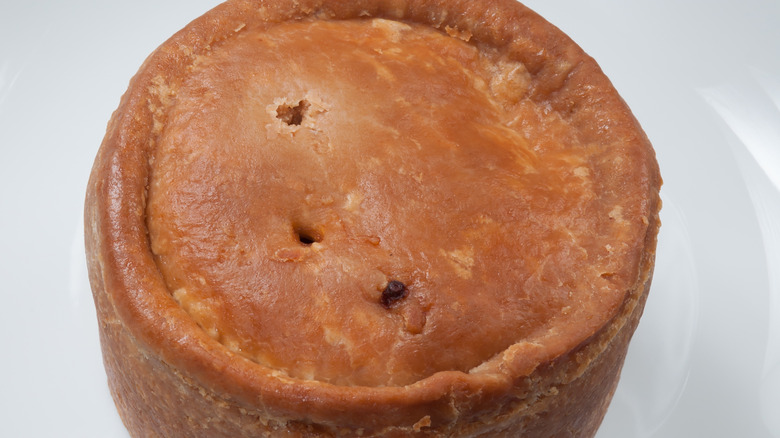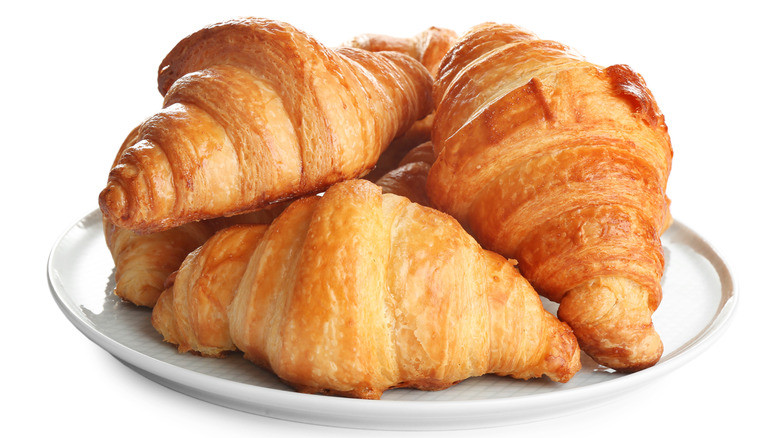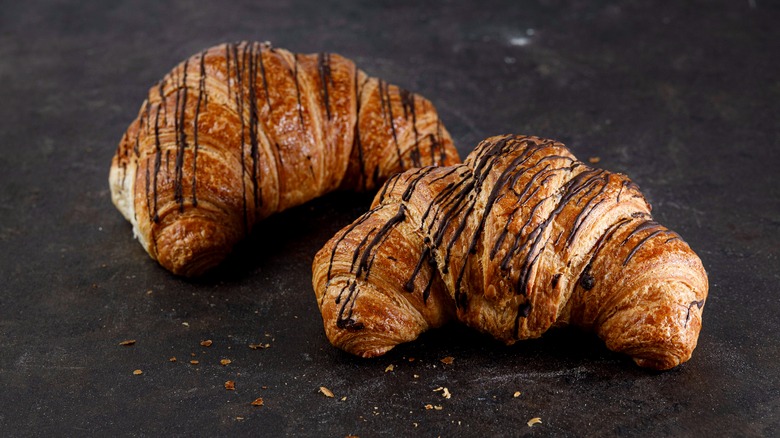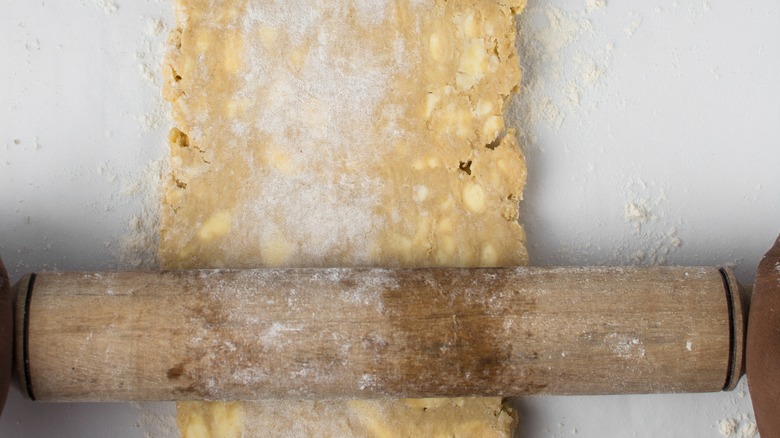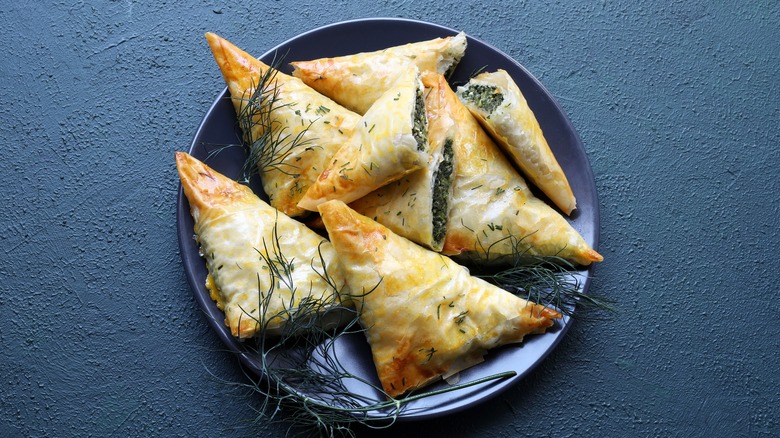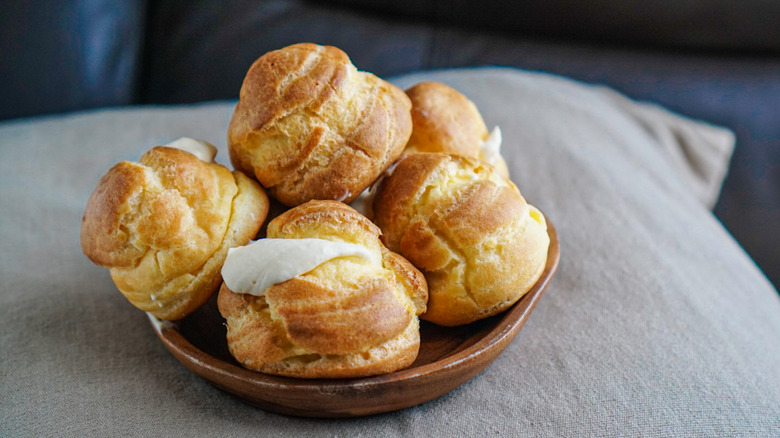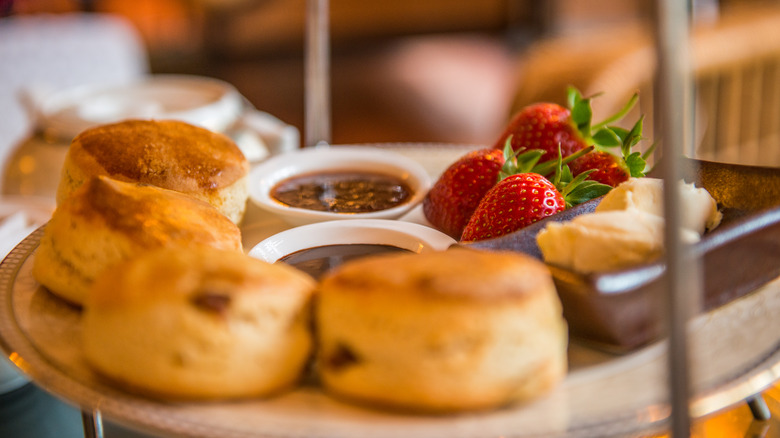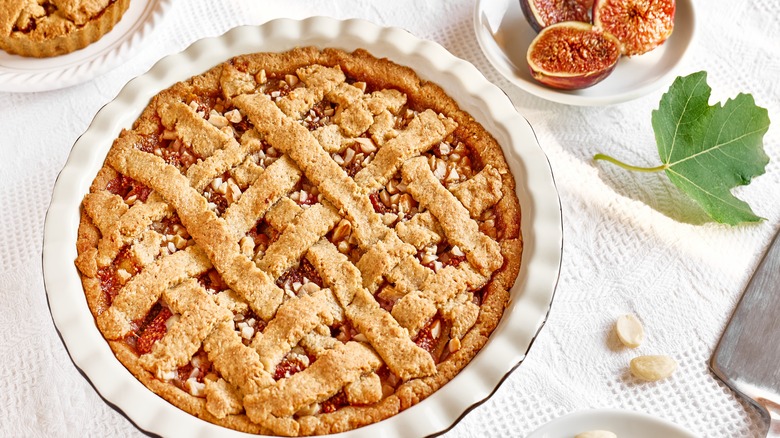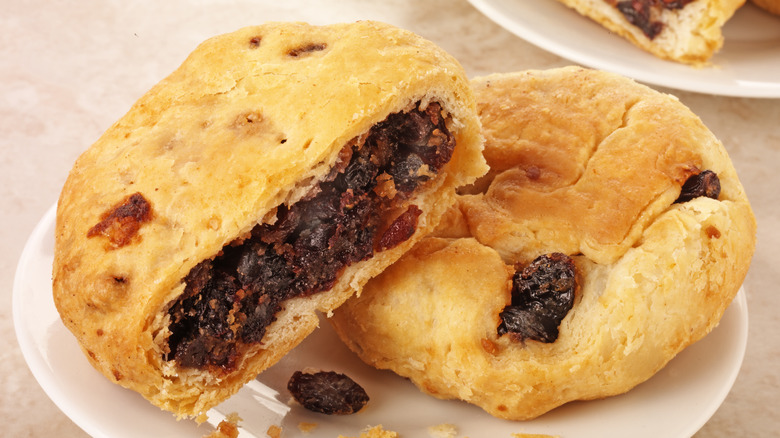10 Types Of Pastry, Explained
The pastry world is a complicated one that fans of the hit television show "The Great British Bake Off" know all too well. Pastry has been a facet of societies long before baking shows, though; the Egyptians were the first society to record mixing fat into dough and wrapping around it meats before cooking. After Northern Europeans invaded the Mediterranean during the Crusades, pastry making was adopted by the Italians and the Europeans. After the 1700s, pastry making became more of an artisan craft and inspired culinary art renditions through figures like Marie-Antoine Carême.
Nowadays, you don't have to travel far to find fine pastry. We should also note the difference between the pastry we're talking about. It's the technique and style of incorporating fat into flour that will become, with the addition of flavorings and artistic infusion, a delectable baked good (which are called pastries). Patisserie refers to French, Italian, or Belgian adaptations of pastry and the shops in which pastries are sold. Confusing, we know. Here's a breakdown of pastry 101: The types, methods, and creations you can whip up by (not so simply) mixing flour and fat.
Laminated versus unlaminated dough
Before you understand the complex world of pastry, you have to understand the difference between laminated and un-laminated dough. The lamination process involves putting large pieces of butter into the dough. This process is very methodical and showcases a pastry chef's ability to fold, rotate, and chill the dough. When laminated pastry is placed in the oven, the butter melts, creating pockets of steam that give the dough its rise and create easily distinguishable flakes in the pastry. The most common types of treats that utilize a laminated dough style include croissants, danishes, phyllo, and strudel.
Un-laminated dough is a separate class of pastry that involves cutting or rubbing fat into the flour mixture of the dough. Pastries that use this technique, such as brioche, choux, and pie crust, will have some softness to them but not nearly the same puffy texture as a laminated pastry. In addition, a cross-section of this pastry post-bake will have some flake, but not to the extent of a laminated dough.
Shortcrust pastry
Shortcrust pastry is a basic, widely-used form of pastry made by combining chunks of butter with flour. Once the butter begins to form small chunks with the flour, cold water is added to make the dough come together in a ball. The butter prevents the water from soaking the flour and making a goopy mess. The goal of a shortcrust pastry is to keep the dough soft and crumbly while avoiding gluten development. The baker should also be sure to add the water slowly to the dough to prevent over-saturating and causing the dough to harden and become too dense.
After the pastry comes together, it is chilled before being rolled out on a floured surface. Chilling the dough for at least 30 minutes is vital to allow the gluten to slack and the fat to firm up. The resulting texture of the dough is soft, crumbly, and full of tiny pockets of fat resulting in a super flavorful crust. Shortcrust pastry is most commonly used for baking pie crusts. You can flavor the dough with cheese for a savory quiche Lorraine or add chocolate for a chocolate-crusted cream pie.
Hot water crust pastry
Hot water crust pastry is often used for pies because of its durability. You'll commonly see hot water crust pastry used for meat pies and roasted root vegetable pies because it can withstand the weight of the fillings. To make hot water crust pastry, the cook heats water and fat (usually animal lard or vegetable shortening) until it comes to a boil. Then, the fat is poured into a well of flour and stirred until equally moist. Unlike other types of pastry, hot water crust pastry needs to be kneaded to ensure the dough is amply hydrated.
As you might imagine, hot water crust pastry differs greatly from regular pie crust. Per its name, hot water is a key component in pre-gelatinizing the starches in the flour, similar to tangzhong, a Japanese bread-making technique. The resulting texture of the dough is much more pliable, thick, and sturdy. You should consider using cold water for a shortcrust pastry method if you desire a flaky, melt-in-your-mouth feel. The texture of the hot water crust pastry is much more ideal if you plan to take the pie out of the pan and for the crust to maintain its shape. If you are an amateur baker with a tendency to rip holes in your crust, you should also note that hot water crust is easier to repair with chunks of leftover dough.
Puff pastry
Puff pastry is not for the faint of heart. This style of pastry dough is made by methodically interspersing and layering fat in a block of dough. Once the puff pastry dough is baked, the fat melts and the water inside it releases steam. It's the steam that produces the "puff" effect and the desirable qualities in a croissant.
The key to perfecting a puff pastry is to make sure the dough stays cold. If you use butter as your source of fat, you will notice that a warm dough will result in the butter seeping out of the dough while it's baking and not producing the correct puff shape of the dough. You should also keep your oven hot, because an oven that is too cold will not cause the butter to steam — rather it will just seep out of the dough. Most puff pastry recipes call for baking at 400 F to produce both a brown color and the perfect puff.
If making puff pastry is not your forte, you can make your life easier by purchasing frozen puff pastry and leaving it in the freezer for when you need it. Use puff pastry to wrap a beef Wellington or delicately craft a chicken pot pie.
Viennoiserie
Viennoiserie is a hybrid of pâtisserie and French bread. Unlike other types of pastry, viennoiserie usually includes an active yeast culture and white flour, along with the help of enriching agents like butter, eggs, or milk. It's believed that this hybridized pastry is rooted in Austria and eventually made its way to French life by the end of the 1830s.
The ingredients of the viennoiserie set the dessert apart from others in a French storefront. You'll notice that viennoiseries are much more golden brown in color because of the enriching agents. The texture, French Forever notes, is a flaky, crunchy exterior with an interior like of either soft thin layers or soft doughy bread. Unlike other kinds of pastry you'd find in Europe, viennoiseries are usually eaten for breakfast rather than as an after-dinner treat. Some of the most popular viennoiseries you may find in a French shop include the le pain au chocolat, le pavé suisse (Swiss brioche), and chouquettes.
Rough puff pastry
Rough puff pastry is similar to its non-rough namesake, but its ingredients come together faster and less arduously than a traditional puff pastry. This dough requires significantly fewer folds and less time between folding, thus making it the perfect dough if puff pastry feels much too difficult to make by yourself. One of the major downsides of using rough puff pastry over other pastry types is that the dough won't produce the same rise as a puff pastry, so it is best to stick to recipes like beef Wellington and Napoleon cake.
To make a rough puff pastry, a baker must incorporate golf-ball-sized chunks of fat into the dough (rather than the entire slabs used in puff pastry). Then, the dough is quickly rolled, sheeted, and folded with no resting time in between. The resulting dough has deliciously (but less consistently placed) airy fat layers. Some bakers will add lemon juice to the dough to it tender during the folding process.
Filo pastry
Filo dough (also spelled as phyllo dough) is a thin type of pastry dough that differs from puff pastry. Filo dough originated in the Mediterranean region and eventually spread to other regions in the Eurasian subcontinent. Bakers include flour, water, fat, salt, and vinegar together to form very, very thin sheets of dough. Once the sheets are formed, the dough can be stacked, shaped, and formed into baked goods like sticky baklava and spanakopita.
Filo dough is very fragile, so once it is formed into sheets, the dough is frozen until it is ready to be used. If you mistakenly use filo before it is thawed, however, the dough will crack, split, and become useless. The dough also tends to dry very quickly because it is thin, so if you work with filo dough, you should complete all other preparation steps before removing the dough from your refrigerator.
If you plan on working with filo at home, you should know to keep melted butter handy. Traditionally, sheets of filo are stacked with butter in between and baked until golden brown and flaky. The result is a texture similar to puff pastry, but rarely will bakers substitute filo dough and puff pastry interchangeably. Puff pastry is much thicker and will not offer the same mouth-feel as thin filo pastry.
Choux pastry
A pâte à choux is used to make many french pastries like éclairs, cream puffs, and gougères. To make a choux, a baker will bring water, milk, butter, sugar, and salt to a boil before adding flour and stirring until the mixture comes off the sides of the pot. It is important for the baker to cook the dough for long enough to evaporate most of the moisture from the dough; this allows eggs to be more easily incorporated in a stand mixer. Next, the baker pipes the choux dough into the desired shape and bakes until golden brown. Once the pastry has finished baking, it can be filled and served. The resulting choux pastry is light, fluffy, and hollow in the center.
Choux works via the same mechanics as puff pastry — with steam. Choux pastry contains both milk and water, but bakers can get creative by substituting these ingredients for a flavor infusion. You can use earl grey tea rather than water, for example, for a bigger and more flavorful puff. More milk will darken the choux, so the baker must be able to play with the ratios of water and milk in the recipe. The baker can also substitute butter for more flavorful fats like duck fat, but must be aware that the hydration of the fat will alter the resulting puff.
Champagne pastry
"Champagne pastry" is a bit of a misnomer, as this style of pastry actually does not, surprisingly, use any alcohol. It is made with a blend of self-raising flour, which is a mixture of regular flour, a leavening agent, and cornflour. Some recipes will also add plain flour to the mixture in varied proportions, depending on the desired texture of the pastry. It is considered an unleavened pastry variety because the butter is grated into the mixture rather than folded.
This pastry's mixture of different flour types creates a cake-like texture rather than the same lightness as a puff pastry or phyllo pastry. Moreover, the corn flour creates a little mealier texture that wonderfully complements many fruit ingredients like apples and blueberries. Champagne pastry can be used for several recipes, including tarts and pies, because it is pretty easy to work with and can hold a juicy filling.
Biscuit pastry
As its name implies, biscuit pastry has the shortness of a cookie, so it varies immensely from the texture most people think about when they think of a "pastry." This dough is formed by beating butter, sugar, and egg together before adding flour. Beating the butter maximizes the air held in the dough, creating a distinguishable texture. Biscuit pastry typically contains sugar, so it's only used for sweet applications like pies and tarts.
Like other types of pastry, biscuit pastry needs to be kept cold to maintain its shape and is easy to work with. Once you've shaped and chilled your dough, you can brush it with egg whites for a beautiful luster before baking. We recommend working with this type of pastry before experimenting with a laminated pastry; it's both sturdy and forgiving for bakers and wet filling alike. Just make sure not to overwork the dough, as it can beat the air out of the pastry and cause the gluten strands to strengthen, yielding a tough pastry.
Flaky pastry
Flaky pastry is essentially a cross between a puff pastry and standard pie dough. This pastry type can be attractive for bakers because it is easier to make than a puff pastry but will still require some rudimentary folding. First, small pieces of butter are rubbed into the flour. Then, a few pieces of flour are sprinkled on top of the dough before it's folded into layers and chilled in the refrigerator. From there, the dough is repeatedly rolled and folded as more fat is incrementally added.
Flaky pastry is often used for Eccles cakes or Ecclefechan tarts, but also for turnovers, pastry shells, or pie crust. Once this dough is made, it can be refrigerated for several days or frozen for several months. The ease of use for this pastry is high, and its flaked appearance makes it a visually stunning addition to several different types of desserts, both savory and sweet.
Static Media owns and operates Tasting Table and Mashed.
